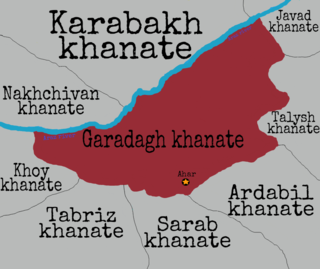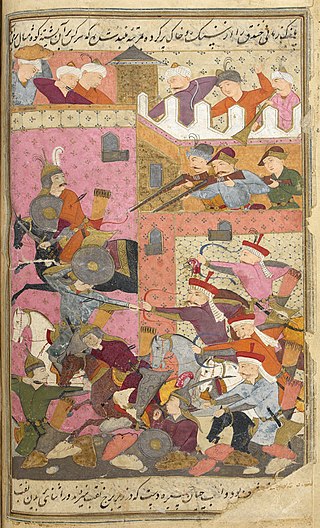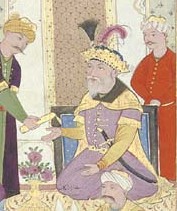
The Oghuz Turks were a western Turkic people who spoke the Oghuz branch of the Turkic language family. In the 8th century, they formed a tribal confederation conventionally named the Oghuz Yabgu State in Central Asia. Today, much of the populations of Turkey, Azerbaijan and Turkmenistan are descendants of Oghuz Turks. Byzantine sources call them Uzes. The term Oghuz was gradually supplanted by the terms Turkmen and Turcoman by 13th century.

The Armenian-Azerbaijani war (1918–1920) was a conflict that took place in the South Caucasus in regions with a mixed Armenian-Azerbaijani population, broadly encompassing what are now modern-day Azerbaijan and Armenia. It began during the final months of World War I and ended with the establishment of Soviet rule.

The Aq Qoyunlu or the White Sheep Turkomans was a culturally Persianate, Sunni Turkoman tribal confederation. Founded in the Diyarbakir region by Qara Yuluk Uthman Beg, they ruled parts of present-day eastern Turkey from 1378 to 1503, and in their last decades also ruled Armenia, Azerbaijan, much of Iran, Iraq, and Oman where the ruler of Hormuz recognised Aq Qoyunlu suzerainty. The Aq Qoyunlu empire reached its zenith under Uzun Hasan.

The Bayandur or Bayundur, is an Oghuz Turkic tribe. Originally one of the 7 original tribes that made up the Kimek–Kipchak confederation, they later joined the Oghuz Turks. The Bayandur originated from Central Asia.
Bayandur is a village in the Akhuryan Municipality of the Shirak Province of Armenia. The Statistical Committee of Armenia reported its population was 690 in 2010, down from 711 at the 2001 census.

Vaghatur is a village in the Tegh Municipality of the Syunik Province in Armenia.
The Bayandur is a Turkic tribe.

In Turkic mythology, Tepegoz or Tepegöz is a legendary creature who has only one eye on his forehead – a kind of cyclops. He is an ogre that appears in the Book of Dede Korkut, a famous epic story of the Oghuz Turks.

Chepni is one of the 24 Oghuz Turkic tribes.

Karadagh Khanate, was a khanate established in the 18th century, with its capital at Ahar.

Yaqub b. Uzun Hasan, commonly known as Sultan Ya'qub was the ruler of the Aq Qoyunlu from 1478 until his death on 24 December 1490. A son of Uzun Hasan, he became the ruler of the dynasty after the death of his brother Sultan Khalil. The borders of Aq Qoyunlu dynasty remained stable during his reign. In his book Alam-Aray-i Amini, Fazlallah Khunji Isfahani praised him as a decent successor of Uzun Hasan. Ya'qub received praise from other historians for supporting poets and scientists.

Turkoman, also known as Turcoman, was a term for the people of Oghuz Turkic origin, widely used during the Middle Ages. Oghuz Turks were a western Turkic people that, in the 8th century A.D, formed a tribal confederation in an area between the Aral and Caspian seas in Central Asia, and spoke the Oghuz branch of the Turkic language family.

Sultan Khalil Mirza was a sultan of the Aq Qoyunlu State, ruling from 6 January 1478 to July 1478.
Jalal ad-Din Ali ibn Qara Yoluq Osman, or Ali Beg was the sixth bey of the Turkoman tribal federation of the Aq Qoyunlu from 1435 to 1438.
Sufi Khalil Beg Mawsilu was a Turkoman military officer from the Mawsillu clan, who served the Aq Qoyunlu. He was one of the leading figures during the reign of Sultan Ya'qub Beg, and played a pivotal role in the succession struggle that took place after the latter's death. He put Ya'qub's eldest son Baysunghur on the throne, ruling as the virtual ruler of the realm until he was defeated and killed by his rival, Sulayman Beg Bijan.

Baysunghur was the ruler of the Aq Qoyunlu from 1490 to 1493. He was the son and successor of Ya'qub Beg. He had little power during his short reign, serving as a figurehead, while real power was in possession of his tutor and commander Sufi Khalil Beg Mawsilu in 1490–1492, and then under another commander, Sulayman Beg Bijan in 1492–1493. Baysunghur was killed in 1493 by his cousin Rustam Beg, who succeeded him.

Alvand Mirza Beg was an Aq Qoyunlu prince, who was a contender for the throne between 1497 and 1504/5.
Pehlavan bey Bayandur was founder and first ruler of Aq Qoyunlu state.

Sultan Murad was the last sultan of the Aq Qoyunlu from 1497 to 1508. After losing his kingdom to the Safavid Shah Ismail I, he fled to Diyar Bakr, where he was eventually killed by Shah Ismail's Qizilbash soldiers at the end of 1514.

Boghach Khan Son of Dirse Khan is a part (boy) of the Book of Dede Korkut. In this boy, the relationships among the Oghuz Turks, their family values, and similar aspects are being discussed in the context of the broader Oghuz Turk community.
















